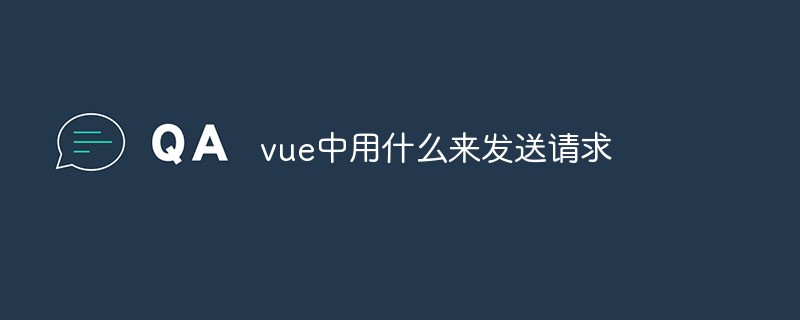vue中用什麼來發送請求
- 青灯夜游原創
- 2022-01-10 14:52:006663瀏覽
在vue中,需要使用vue-resource、axios等外掛程式來傳送請求。 axios是基於Promise的HTTP請求客戶端,用來發送請求,也是vue2.0官方推薦的,同時不再對vue-resource進行更新和維護。

本教學操作環境:windows7系統、vue2.9.6版,DELL G3電腦。
Vue-傳送http請求詳解
1)vue本身不支援傳送AJAX請求,需要使用vue-resource、axios等外掛程式實作。
2) axios是基於Promise的HTTP請求客戶端,用來發送請求,也是vue2.0官方推薦的,同時不再對vue-resource進行更新和維護。
使用axios發送AJAX請求
#1、安裝axios並引入
1)npm的方式: $ npm install axios -S 或cnpm install axios -S
2)bower的方式:$ bower install axios
3)cdn的方式:f155dea2bfdc6b8a01d87d8f35f18fdc2cacc6d41bbb37262a98f745aa00fbf0
2、如何引入使用axios
安裝其他插件的時候,可以直接在main.js 中引入並Vue.use(),但是axios 並不能use,只能每個需要發送請求的元件中即時引入
為了解決這個問題,有兩種開發思路,
一是在引入axios 之後,修改原型鏈
二是結合Vuex,封裝一個aciton
方案一:改寫原型鏈
首先在main.js 中引入axios
import axios from 'axios' Vue.prototype.$http= axios
在元件中發送http請求
this.$http.post('/user',{name: 'xiaoming'})
this.$http({method: 'post',url: '/user',data: {name: 'xiaoming'}})
//发送get请求
this.$http.get('/user?ID=12345')
.then(res=> { console.log(response); })
.catch(err=> { console.log(error); });
this.$http.get('/user',{params:{ID:12345}})
.then(res=> { console.log(response); })
.catch(err=> { console.log(error); });
//发送post请求
this.$http.post('/user',
{name: 'xiaoming'}
)
.then(res=> { console.log(res) })
.catch(err=> { console.log(err)});3、封裝axios進行呼叫
/**** request.js ****/
// 导入axios
import axios from 'axios'
// 使用element-ui Message做消息提醒
import { Message} from 'element-ui';
//1. 创建新的axios实例,
const service = axios.create({
// 公共接口--这里注意后面会讲
baseURL: '',
// 超时时间 单位是ms,这里设置了3s的超时时间
timeout: 3 * 1000
})
// 2.请求拦截器
service.interceptors.request.use(config => {
//发请求前做的一些处理,数据转化,配置请求头,设置token,设置loading等,根据需求去添加
config.data = JSON.stringify(config.data); //数据转化,也可以使用qs转换
console.log('请求拦截器中',config)
config.headers = {
'Content-Type':'application/x-www-form-urlencoded' //配置请求头
}
//注意使用token的时候需要引入cookie方法或者用本地localStorage等方法,推荐js-cookie
// const token = getCookie('名称');//这里取token之前,你肯定需要先拿到token,存一下
// if(token){
// config.params = {'token':token} //如果要求携带在参数中
// config.headers.token= token; //如果要求携带在请求头中
// }
return config
}, error => {
console.log('错误')
Promise.reject(error)
})
// 3.响应拦截器
service.interceptors.response.use(response => {
//接收到响应数据并成功后的一些共有的处理,关闭loading等
return response
}, error => {
console.log('error',error)
/***** 接收到异常响应的处理开始 *****/
if (error && error.response) {
// 1.公共错误处理
// 2.根据响应码具体处理
switch (error.response.status) {
case 400:
error.message = '错误请求'
break;
case 401:
error.message = '未授权,请重新登录'
break;
case 403:
error.message = '拒绝访问'
break;
case 404:
error.message = '请求错误,未找到该资源'
// window.location.href = "/"
break;
case 405:
error.message = '请求方法未允许'
break;
case 408:
error.message = '请求超时'
break;
case 500:
error.message = '服务器端出错'
break;
case 501:
error.message = '网络未实现'
break;
case 502:
error.message = '网络错误'
break;
case 503:
error.message = '服务不可用'
break;
case 504:
error.message = '网络超时'
break;
case 505:
error.message = 'http版本不支持该请求'
break;
default:
error.message = `连接错误${error.response.status}`
}
} else {
// 超时处理
if (JSON.stringify(error).includes('timeout')) {
Message.error('服务器响应超时,请刷新当前页')
}
Message.error('连接服务器失败')
}
Message.error(error.message)
/***** 处理结束 *****/
//如果不需要错误处理,以上的处理过程都可省略
return Promise.resolve(error.response)
})
//4.导入文件
export default service/**** http.js ****/
// 导入封装好的axios实例
import request from './request'
const http ={
/**
* methods: 请求
* @param url 请求地址
* @param params 请求参数
*/
get(url,params){
const config = {
method: 'get',
url:url
}
if(params) config.params = params
return request(config)
},
post(url,params){
console.log(url,params)
const config = {
method: 'post',
url:url
}
if(params) config.data = params
return request(config)
},
put(url,params){
const config = {
method: 'put',
url:url
}
if(params) config.params = params
return request(config)
},
delete(url,params){
const config = {
method: 'delete',
url:url
}
if(params) config.params = params
return request(config)
}
}
//导出
export default httpimport http from './http'
//
/**
* @parms resquest 请求地址 例如:http://197.82.15.15:8088/request/...
* @param '/testIp'代表vue-cil中config,index.js中配置的代理
*/
// let resquest = ""
// get请求
export function getListAPI(resquest,params){
return http.get(`${resquest}/getList.json`,params)
}
// post请求
export function postFormAPI(resquest,params){
console.log('发送post请求')
return http.post(`${resquest}`,params)
}
// put 请求
export function putSomeAPI(resquest,params){
return http.put(`${resquest}/putSome.json`,params)
}
// delete 请求
export function deleteListAPI(resquest,params){
return http.delete(`${resquest}/deleteList.json`,params)
}解決Vue跨域問題:

解決方法:在腳手架中的config下的index.js中
在dev 的proxyTable 物件中加入這些屬性
// Paths
assetsSubDirectory: 'static',
assetsPublicPath: '/',
proxyTable: {
"/api":{
target:"https://xin.yuemei.com/V603/channel/getScreenNew/",//接口域名
changeOrigin:true,//是否跨域
pathRewrite:{
"^/api":""//重写为空,这个时候api就相当于上面target接口基准地址
}
}
},然後請求這裡用axios請求
請求的時候前綴api就相當於基準位址了
axios.post("/api").then(res => {
console.log(res);
this.data = res.data.data;
});
//如果有参数请求
axios.post("/api?key=111").then(res => {
console.log(res);
this.data = res.data.data;
});設定完記得重跑一下項目(記得)
想要傳送Ajax請求透過兩種方式
一:透過XHR物件
二:透過fetch函數【相關推薦:請求行:
method:post 或get url:請求位址
##請求頭:host:主機位址cookie
content-type:請求體內容
請求體:回應行:status回應頭:多個回應頭回應體:json/圖片/css/js/html
vue.js教學】#
以上是vue中用什麼來發送請求的詳細內容。更多資訊請關注PHP中文網其他相關文章!

